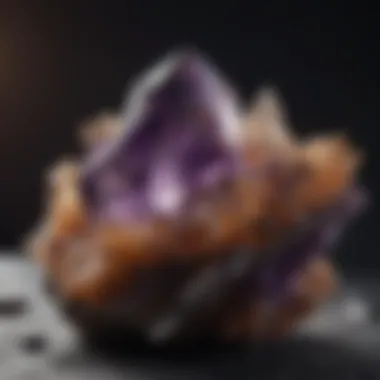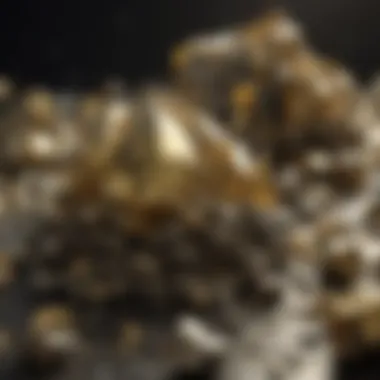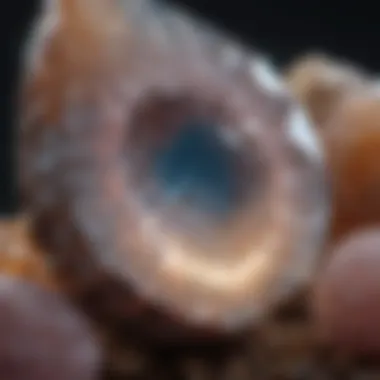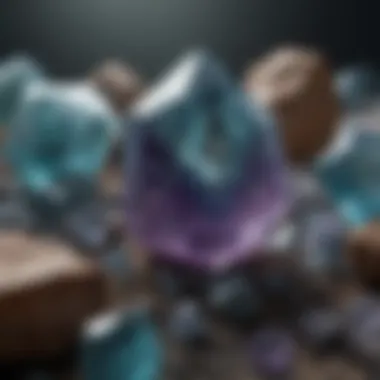Unveiling the Enigmatic World of Raw Crystal Rocks: A Comprehensive Exploration


Rock and Fossil Identification
In the captivating world of raw crystal rocks, the first step towards understanding their essence lies in rock and fossil identification. As a rock and fossil collector, recognizing the various types of rocks and fossils is essential. Whether it's identifying quartz, amethyst, or agate, each specimen carries distinctive characteristics that set it apart. Look for key features such as color, texture, and crystal structure to differentiate between different types of raw crystal rocks. Utilizing tools like magnifying glasses, UV lights, and hardness testing kits can aid in the precise identification of these geological treasures.
Geological Insights
Delving deeper into the geological insights of raw crystal rocks unveils a world of wonder and intrigue. Understanding the geological formations and processes that contribute to the creation of these natural marvels enriches one's appreciation for their beauty. From the slow crystallization process in igneous rocks to the pressure and heat metamorphic rocks endure, each formation reveals a unique narrative of Earth's history. Exploring the historical significance of rocks and fossils offers a glimpse into the past, reflecting significant moments in the development of our planet. Unearthing notable discoveries in the field of geology sheds light on groundbreaking findings that have expanded our understanding of raw crystal rocks and their place in the natural world.
Introduction to Raw Crystal Rocks
In this article, we delve into the enchanting realm of raw crystal rocks, unveiling their unique properties, formation processes, and significance in the spheres of geology and collections. From the allure of crystal formations to the intricate details of crystal identification, this piece serves as a comprehensive guide for enthusiasts and novices alike. Raw crystal rocks hold a mysterious beauty and endless fascination for rock and fossil collectors, offering a glimpse into the wonders of the Earth's geological history and the artistry of nature's formations.
Understanding Crystal Structures
The Basic Composition of Crystals
The fundamental composition of crystals forms the basis of their physical and chemical properties, shaping their overall characteristics and functionalities. Understanding the basic composition of crystals involves analyzing their atomic makeup, elemental components, and molecular arrangement. This knowledge is crucial in determining a crystal's stability, transparency, and behavior under different conditions. The symmetry and orderly structure of crystals stem from their unique composition, influencing factors such as color, hardness, and cleavage patterns. Recognizing the basic composition of crystals is essential for crystal enthusiasts and collectors to identify, classify, and appreciate the diversity of raw crystal rocks.
The Role of Atomic Arrangement in Crystal Formation
The atomic arrangement within crystals plays a pivotal role in their formation and growth processes. The precise organization of atoms and molecules dictates the outward appearance and internal structure of crystals, imparting them with distinctive properties and symmetrical shapes. The atomic arrangement influences crystal cleavage, crystal faces, and crystal habit, shaping the visual aesthetics and mineralogical characteristics of each crystal specimen. Understanding the role of atomic arrangement provides insights into how crystals develop, transform, and interact with their surrounding environments, offering a deeper appreciation of their geological significance and intrinsic beauty.
Formation Processes of Raw Crystals
Natural Crystal Growth
The Influence of Pressure and Temperature
The influence of pressure and temperature plays a pivotal role in the natural growth of crystals. Pressure and temperature affect the rate of crystal growth, influencing the size and clarity of the crystals formed. High pressure leads to compact crystal structures, while variations in temperature can result in diverse crystal forms. Understanding this interplay between pressure and temperature allows for insights into the environmental conditions that contribute to crystal formation.
Within this article, exploring the nuances of pressure and temperature in crystal growth provides a deeper understanding of how geological processes shape raw crystals. The unique feature of pressure and temperature control in crystal growth lies in their ability to yield crystals with distinct characteristics based on environmental variables. These factors are essential for collectors and researchers seeking to differentiate crystal specimens based on their formation conditions, showcasing the significance of pressure and temperature in enriching the study of raw crystals.


Formation within Voids and Cavities
The formation of crystals within voids and cavities showcases an intriguing aspect of crystal growth. Voids and cavities in rocks provide spaces for crystal nucleation and growth, leading to the formation of exceptional crystal specimens. The confinement within these spaces influences crystal habit and structure, generating exquisite formations that captivate collectors and researchers alike.
Exploring formation within voids and cavities in this article highlights a unique aspect of crystal growth that contributes to the diversity of raw crystal rocks. The key characteristic of crystals formed in voids and cavities is their distinct shapes and sizes, molded by the constraints of their environment. Understanding this process provides valuable insights into the natural variations of crystal formations, emphasizing the importance of exploring different growth environments for a comprehensive study of raw crystals.
Significance of Raw Crystals in Geology
In the vast landscape of geology, raw crystals hold a significant position that goes beyond their aesthetic allure. These mineral formations are not merely decorative items but are integral indicators of geological processes that have shaped our planet over millions of years. By examining raw crystals, geologists can unlock a treasure trove of information about Earth's history, environmental conditions, and the forces that have sculpted its surface. This section delves deep into the importance of raw crystals in understanding geology, shedding light on their invaluable role in unraveling the mysteries of our planet's past and present.
Indicators of Geological Processes
Crystal Inclusions as Geological Time Capsules
Crystal inclusions serve as remarkable time capsules, encapsulating small pockets of fluids, gases, or minerals that provide crucial insights into the conditions present during the crystal's formation. These microscopic inclusions act as snapshots of Earth's past, offering geologists a rare glimpse into the environmental parameters, temperature fluctuations, and mineral compositions prevalent at the time of crystal growth. By studying these inclusions, scientists can piece together a detailed narrative of geological events, volcanic activities, and tectonic movements that have left their mark on the crystal lattice. Despite their diminutive size, crystal inclusions play a massive role in reconstructing the intricate tapestry of Earth's geological evolution, making them indispensable tools for geologists worldwide.
Crystal Morphology and Environmental Clues
The morphology of crystals and the environmental clues they carry are like cryptic messages waiting to be deciphered by keen-eyed geologists. The external features of a crystal, such as its shape, size, and faceting, can hint at the growth conditions under which it formed, indicating aspects like temperature, pressure, and fluid composition. Additionally, the presence of specific minerals within a crystal's structure can unveil the geological environments in which the crystal originated, offering valuable clues about the rock formations, metamorphic processes, or volcanic activities that have influenced its growth. By scrutinizing the morphology and analyzing the environmental clues embedded within raw crystals, geologists can unveil a wealth of geological information, paving the way for a deeper understanding of the Earth's dynamic history and geological processes.
Identification and Classification of Raw Crystals
Raw crystals hold a fascination for many enthusiasts, and understanding their identification and classification is crucial in appreciating their beauty and uniqueness. The process of identifying and classifying raw crystals involves examining specific physical characteristics that set each type apart. By delving into these details, collectors and geology enthusiasts can gain a deeper insight into the world of raw crystals. One key benefit of focusing on the identification and classification of raw crystals is the ability to distinguish between different types based on their distinct features, aiding in accurate categorization and appreciation of their individual traits.
Physical Characteristics for Identification
Color, Transparency, and Luster
The color, transparency, and luster of raw crystals serve as essential markers in their identification process. Color often reflects the mineral content present in a crystal, with variations indicating different impurities or mineral combinations. Transparency provides insight into the internal structure of the crystal, ranging from opaque to transparent, influencing its visual appeal. Moreover, luster describes the way light interacts with the surface of a crystal, categorizing it as metallic, resinous, or vitreous, enhancing its aesthetic allure. Understanding color, transparency, and luster is vital in differentiating raw crystals, allowing collectors to appreciate their beauty and uniqueness.
Crystal Habit and Cleavage Patterns
Examining crystal habit and cleavage patterns reveals further intricacies in the identification and classification of raw crystals. Crystal habit refers to the external shape and structure in which a crystal naturally grows, impacting its overall appearance. Cleavage patterns signify the way a crystal breaks along planes of weakness, indicating its internal atomic arrangement. Recognizing crystal habits and cleavage patterns aids collectors in identifying raw crystals accurately, distinguishing one type from another with precision. By studying these characteristics, enthusiasts can deepen their understanding of raw crystals' formation and composition, enhancing their appreciation for these natural wonders.


Common Types of Raw Crystals
Quartz Varieties: Amethyst, Citrine, and Rose Quartz
Quartz varieties such as Amethyst, Citrine, and Rose Quartz showcase distinct characteristics that make them prominent in the world of raw crystals. Amethyst, known for its purple hue, signifies inner strength and clarity, while Citrine's golden tones symbolize success and abundance. Rose Quartz, with its delicate pink color, embodies love and compassion. These quartz varieties offer a range of metaphysical and healing properties, appealing to collectors and enthusiasts alike for their diverse energy attributes. Understanding the unique features of Quartz varieties enriches the exploration of raw crystals' significance and variety.
Calcite, Fluorite, and Their Distinctive Features
Calcite and Fluorite stand out among raw crystals due to their distinctive features that set them apart from other varieties. Calcite's vibrant colors and rhombohedral cleavage make it a striking addition to any collection, representing cleansing and renewal. Fluorite's multi-color schemes and octahedral crystal habit evoke clarity and mental focus, making it a sought-after crystal for its balancing qualities. Delving into the distinctive features of Calcite and Fluorite enhances the breadth and depth of raw crystal classifications, highlighting the diversity present in the world of geology and collectors' treasures.
Collecting and Preserving Raw Crystals
When delving into the enticing realm of raw crystal rocks, understanding the significance of collecting and preserving them is paramount. In this comprehensive guide, we will explore the essential elements and benefits associated with the meticulous process of collecting and preserving these magnificent formations. Collecting raw crystals is not only a hobby but also a way to appreciate the beauty of nature's creations while understanding the historical and geological significance embedded within each specimen. The act of preserving raw crystals goes beyond mere storage; it involves ethical considerations, proper care techniques, and sustainable practices to ensure the longevity and integrity of these precious stones. By examining the methods of collecting and preserving raw crystals, enthusiasts can deepen their connection to these geological wonders and contribute to the preservation of Earth's natural resources.
Ethical Sourcing Practices
Responsible Mining and Fair Trade Policies
Responsible mining and fair trade policies play a crucial role in the ethical sourcing of raw crystals, aligning with the overarching goal of promoting sustainability and environmental awareness. By adhering to responsible mining practices, companies and collectors can minimize the ecological impact of crystal extraction, protect natural habitats, and support local communities dependent on mining activities. Fair trade policies ensure that miners receive fair wages and work in safe conditions, fostering a transparent and equitable supply chain for raw crystals. The key characteristic of responsible mining and fair trade policies lies in creating a harmonious balance between economic development and environmental preservation, making it a popular choice for conscientious collectors and geology enthusiasts alike.
Supporting Sustainable Crystal Harvesting
Supporting sustainable crystal harvesting practices is essential for maintaining the delicate ecological balance of crystal-rich regions worldwide. By endorsing sustainable harvesting methods, collectors and businesses can contribute to the responsible management of crystal deposits, preventing overexploitation and habitat destruction. Sustainable crystal harvesting prioritizes long-term environmental conservation over short-term gains, ensuring that future generations can continue to enjoy the beauty and benefits of raw crystals. Its unique feature lies in fostering a holistic approach to crystal extraction, incorporating ecological considerations and community welfare into harvesting practices, thus promoting a more sustainable and ethical industry.
Preservation Techniques for Crystal Care
Cleaning, Storing, and Displaying Guidelines
Proper cleaning, storing, and displaying of raw crystals are essential practices to maintain their aesthetic appeal and structural integrity. Cleaning raw crystals requires delicate handling to avoid damage, utilizing gentle cleaning solutions and soft brushes to remove dirt and impurities effectively. Storing crystals in a cool, dry place away from direct sunlight helps prevent discoloration and deterioration over time. Displaying guidelines involve choosing suitable display cases or shelves that protect crystals from dust and physical harm while showcasing their beauty to admirers. The key characteristic of cleaning, storing, and displaying guidelines is their ability to preserve the natural beauty of raw crystals while ensuring their longevity and pristine condition, making them a popular choice for collectors seeking to showcase their prized specimens.
Avoiding Common Damage Risks


Mitigating common damage risks is vital in safeguarding raw crystals from potential harm or degradation. By understanding and avoiding factors such as exposure to extreme temperatures, direct sunlight, or harsh chemicals, collectors can prevent structural damage and color fading in their crystal collections. Implementing preventative measures like using protective padding in storage containers and avoiding overcrowding display areas can reduce the risk of accidental breakage or scratches. The unique feature of avoiding common damage risks is its proactive approach to crystal preservation, empowering collectors to take proactive steps in safeguarding their precious specimens and maintaining their allure for years to come.
Exploring Geological Wonders Through Raw Crystals
In this article, 'Exploring Geological Wonders Through Raw Crystals' serves as a captivating exploration of remarkable crystal locations worldwide. By delving into these geological marvels, enthusiasts and beginners alike gain insight into the mesmerizing beauty and historical significance of raw crystal rocks. This section sheds light on the allure of crystal formations found in nature's wonders, bridging the gap between science and artistry.
Famous Crystal Locations Around the World
The Majestic Beauty of Quartzite Caves
The majestic beauty of quartzite caves exemplifies nature's intricate craftsmanship at its finest, showcasing crystalline formations in their purest form. These caves are renowned for their ethereal glow, caused by the unique way light interacts with the quartz crystals within. Visitors are mesmerized by the iridescent surfaces that reflect and refract light with exquisite brilliance. The caves' natural acoustics amplify their mystique, creating a sensory experience unlike any other. For this article, the majestic beauty of quartzite caves offers a visual feast and a testament to the Earth's geological wonders.
Crystal Mines in South America and Africa
Crystal mines in South America and Africa stand as hubs of raw crystal discovery, attracting miners and collectors seeking pristine specimens. These mines yield a diverse array of crystals, each with its distinct properties and allure. From amethyst clusters to vibrant tourmaline, these mines offer a glimpse into the geological wealth that lies beneath the Earth's surface. Their cultural and economic significance cannot be understated, shaping local communities and global markets alike. For this article, exploring crystal mines provides a glimpse into the labor and ingenuity required to unearth nature's treasures.
Impact of Crystals on Cultural and Historical Narratives
The impact of crystals on cultural and historical narratives spans millennia, with civilizations worldwide attributing mystical powers and symbolic meanings to these precious stones. Ancient rituals and artifacts often incorporate crystals for their purported healing and protective properties, underscoring their enduring presence in human history. By examining these practices, we uncover the intricate relationship between crystals and spirituality, shedding light on the beliefs and traditions that have shaped diverse cultures. For this article, delving into ancient crystal uses enriches our understanding of how crystals have woven themselves into the fabric of society.
Symbolism of Crystals in Different Civilizations
The symbolism of crystals in different civilizations reflects a universal fascination with these natural marvels, transcending geographical and cultural boundaries. From ancient Egypt to modern-day Japan, crystals have held symbolic significance as talismans, decorations, and tools for divination. Each civilization bestows its unique interpretation onto crystals, infusing them with meanings that resonate deeply within their respective societies. By exploring this symbolism, we unravel the intricate tapestry of cultural beliefs and practices that have endured through generations. For this article, analyzing the symbolism of crystals offers a lens into the diverse ways in which human cultures have embraced these treasures of the Earth.
Conclusion: Embracing the Allure of Raw Crystal Rocks
In the kaleidoscopic realm of raw crystal rocks, the Conclusion serves as the pinnacle of our exploration, encapsulating the essence of allure that these mesmerizing formations exude. This segment acts as a heartfelt ode, beckoning individuals to not merely observe but to immerse themselves in the captivating world of crystals. What sets this Conclusion apart is its ability to transcend mere appreciation and venture into a profound connection with the raw beauty and energy that crystals offer.
Within the tapestry of this article, the Conclusion: Embracing the Allure of Raw Crystal Rocks stands as a beacon, signaling the transition from passive admiration to active engagement. It prompts readers to embrace the splendor of these gem-like treasures and invites them to delve deeper into the enchanting narratives that crystals whisper through their crystalline forms.
This section implores enthusiasts and beginners alike to not only seek the external beauty of crystals but also to unravel the inner complexities and energies they harbor. By embracing the allure of raw crystal rocks, individuals can embark on a transformative journey of self-discovery, forging connections with nature's pristine creations and aligning with the Earth's ancient rhythms.
The Conclusion: Embracing the Allure of Raw Crystal Rocks is a celebration of the intrinsic allure that these geological wonders possess—a reminder that beauty goes beyond surface aesthetics and delves into the depths of spiritual resonance and healing energies. It encapsulates the essence of raw crystal rocks as more than just physical entities but as conduits of harmony, balance, and enlightenment. Through this Conclusion, readers are encouraged to embark on their own intimate exploration of the versatile and enchanting world of crystals.
Appreciating the Beauty and Diversity of Crystal Specimens
A Journey into the Intriguing World of Raw Crystals
The segment







